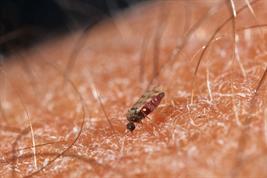25.03.2025

A new study shows that the transmission of livestock disease pathogens by biting midges of the genus
Culicoides may also occur in winter. These tiny blood-feeding insects are considered to be the main vectors of bluetongue virus and Schmallenberg virus, which can be dangerous for ruminants such as cattle and sheep. Researchers from the Leibniz Centre for Agricultural Landscape Research (ZALF) and the Friedrich-Loeffler-Institut (FLI) have investigated the winter activity of these insects on farms in Germany. The findings were published in the journal
Medical and Veterinary Entomology. They shed new light on the concept of a so-called vector-free period, during which the vectors are considered inactive, and the possibility of virus transmission is considered unlikely.
It is assumed that there is a period in Central Europe in winter when
Culicoides biting midges are not active and, therefore, no transmission of the bluetongue and Schmallenberg virus can occur. There are threshold values in the EU for determining a vector-free period. These are based on how many active, formerly blood-sucked biting midges were caught per night and trap. If this number exceeds the threshold value, there is no vector-free period. Therefore, transmission of the virus can no longer be ruled out, and trade restrictions come into force accordingly. Epidemiological data had already indicated that the bluetongue virus was able to persist in the winter and reappeared the following year in the infested regions. The current study provides further evidence that biting midges are active even in the coldest months, particularly in livestock buildings. They could, therefore, contribute to continuous virus transmission. This calls into question the previous assumption of a pronounced vector-free period.
Researchers´ approach and the results
For the study, the researchers investigated the activity of biting midges in two winter periods (October to April 2019/2020 and 2020/2021) on 16 farms in Germany. The biting midges were caught with UV-light traps, a common trapping method, both outside and inside the stables. Over 32,000
Culicoides biting midges were caught in 960 trapping events, of which over 60% were caught in stables. It was particularly striking that even in the coldest months of January and February, specimens were detected in the stables while they nearly disappeared outside.
The researchers were able to prove that around 2,000 of the
Culicoides biting midges caught had ingested blood - almost 95% of which were caught in the stables.
"Our results show that
Culicoides are also active in stables in winter. The viruses they transmit could, therefore, also persist there. As biting midges can take a blood-meal in winter, the transmission of viruses is also possible at this time of year," explains
Sarah Groschupp from ZALF, first author of the study
Temperature as a Key Factor
The researchers found that the biting midge activity strongly depends on the temperature. Some species of biting midges, which are considered vectors of bluetongue and Schmallenberg viruses, were caught at an average temperature of 7.4°C, with a minimum of only 0.3°C. Temperatures inside the stables were higher than outside for longer periods, favoring the biting midge winter activity.
"Our data show that a vector-free period in stables may not exist or may only exist for a short time," emphasizes co-author
Dr. Doreen Werner from ZALF. "This could mean that the current measures for trade in livestock and their products in outbreak areas in winter need to be reconsidered. The locations where the biting midges are caught, i.e. whether inside or outside the stables, also play an essential role in defining a vector-free period."
Further investigations should now clarify the extent to which the winter activity of
Culicoides biting midges influences actual virus transmission.
Further Information:
